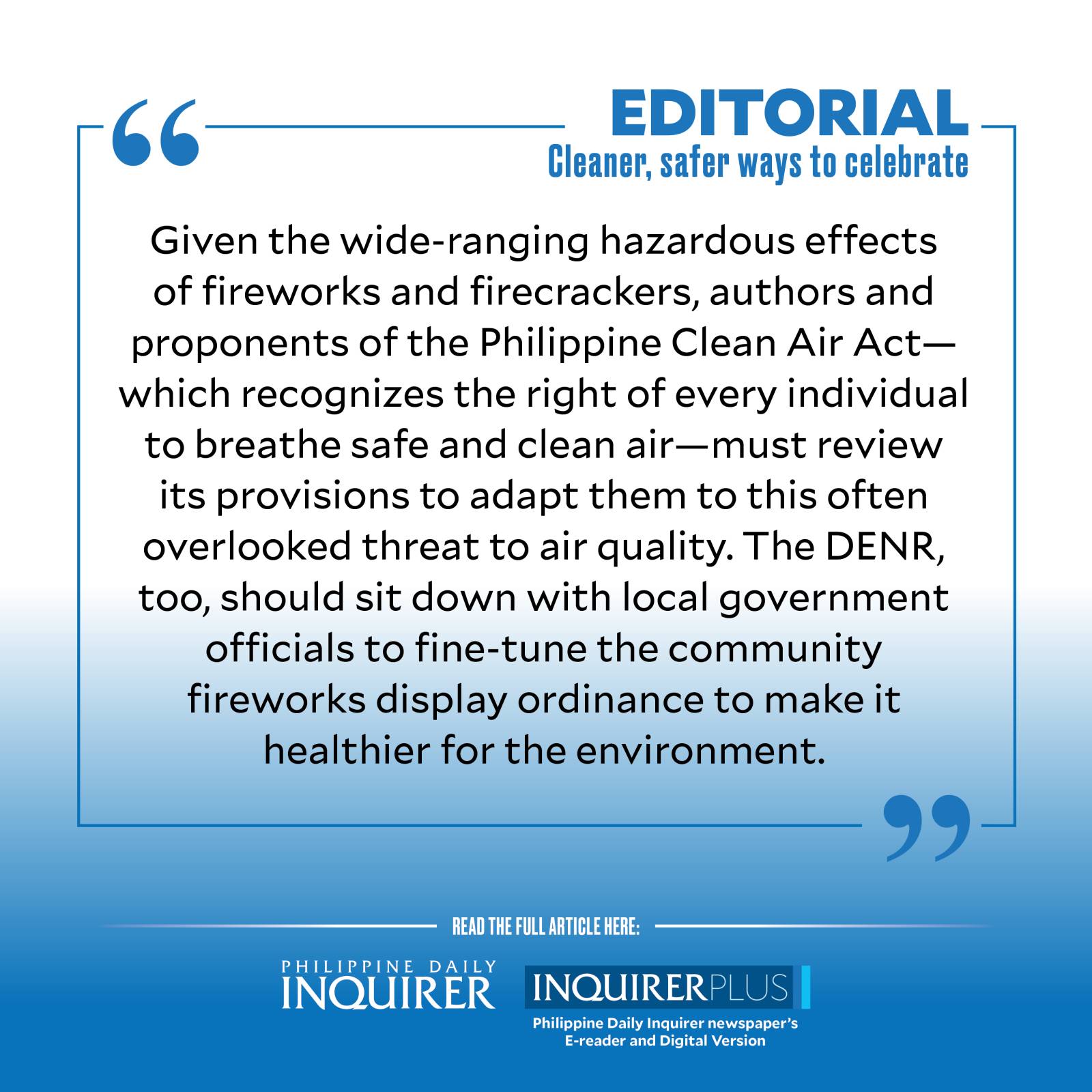Cleaner, safer ways to celebrate

While the New Year revelry brought with it the exuberance of new hopes and aspirations, it also left behind a monstrous smog, a blight hazardous to both health and the environment.
Data from the Department of Environment and Natural Resources (DENR)-Environmental Management Bureau (EMB), showed that several Metro Manila cities suffered from “acutely unhealthy” ambient air quality on New Year’s Day following the previous night’s merrymaking that included lighting fireworks and firecrackers.
A high level of suspended particles—like dust from unpaved roads—was detected in several cities including Makati, Mandaluyong, and Pateros where air quality was deemed “very unhealthy.” Air in Taguig City and Pasig City was considered “unhealthy for sensitive groups,” and “fair” in Caloocan City and San Juan City.
Thermal inversion
Although the air eventually cleared toward early evening, the DENR in an earlier statement cautioned people to limit outdoor exertion while those with heart or respiratory diseases like asthma were advised to stay indoors. It warned that although “some of these particles can be filtered by the body, these can irritate the eyes, nose, and throat.” The United States-based Centers for Disease Control and Prevention meanwhile described the fine particles as “dangerous because they can get into the deep parts of your lungs—or even into your blood.”
While the DENR-EMB does not consider fireworks as identified sources of emissions under the Philippine Clean Air Act—which focuses mainly on industrial and vehicular fumes—a specialist at the state weather bureau directly traced the “thermal inversion” in Metro Manila and parts of Calabarzon (Cavite, Laguna, Batangas, Rizal, Quezon) to fireworks. The thick smog that blanketed these areas was the result of the “components in the drying particles of these fireworks [coming together with] the pollution in our environment,” the weather expert pointed out.
Global tradition
Apparently, the fireworks ban on individual households and the widely practiced community fireworks display, which admittedly saved many lives and limbs, failed to make a dent in reducing the air pollution level the morning after.
But given the global tradition of lighting up the skies to welcome another year and making as much noise to “chase away evil,” as the old belief goes, is it possible to tweak this widely accepted but inherently unhealthy and hazardous mode of celebration? It may be quixotic, even uncool, to consider the use of alternative merrymakers like pots and pans, paper horns, or “torotot” as suggested by the Philippine Medical Association and the environmental group EcoWaste Coalition, but as recent studies suggest, it may be necessary in the long run for our survival and that of the planet. There are also the light displays and drone shows for community celebrations.
Since breathing clean air is a basic necessity for well-being, elevated levels of pollutants in the atmosphere remain a significant global health concern, with the World Health Organization reporting in 2005 that urban indoor and outdoor air pollution (OAP) causes more than two million premature deaths worldwide, especially in developing countries where restrictions on polluting factories and vehicles are loosely implemented.
Detrimental health risks
In urban areas where congestion means a higher concentration of people and air pollutants, poor air quality poses detrimental health risks, especially to those working outdoors like transport workers, traffic enforcers, drivers, and daily commuters. Most vulnerable are children who breathe in higher volumes of air compared to adults, those with preexisting cardiac or respiratory diseases, as well as pregnant women, the elderly, and immunocompromised folk.
For developing countries like the Philippines, OAP can drain scarce resources that could be better used for productive pursuits.
Air pollution has also been linked to climate change, since particle pollutants directly absorb sunlight, thus heating the surface atmosphere even more. The toxic powdered chemicals in fireworks can also flow into rivers and streams, contaminating irrigation channels and our sources of groundwater.
Safe and clean air
Given the wide-ranging hazardous effects of fireworks and firecrackers, authors and proponents of the Philippine Clean Air Act—which recognizes the right of every individual to breathe safe and clean air—must review its provisions to adapt them to this often overlooked threat to air quality. The DENR, too, should sit down with local government officials to fine-tune the community fireworks display ordinance to make it healthier for the environment. Meanwhile, can government scientists take a closer look at the toxic chemicals inside firecrackers to study ways to find safer alternatives? True, it may take a lot of convincing to change people’s default mode of celebrating the new year but finding better, healthier, and cleaner ways to have a blast should be worth all that effort.




















